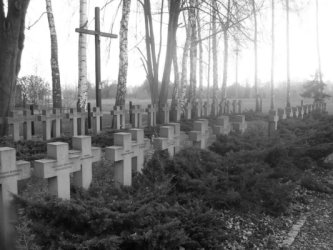When the Warsaw Uprising was coming to an end and the landing operation on the left bank Warsaw undertook by the Soviet's Polish First Army commanded by General Zygmunt Berling came out to be insufficient, and as such could not change the course of the battle of Warsaw and ended up with defeat, German forces under command of the SS General Erich von dem Bach pacified a defiant Polish city, the command of the German 9th Army had spare resources that could be used outside of Warsaw and turned their attention to their rear, especially the Puszcza Kampinowska area. According to the German headquarters' sources, there were about 15 000 Polish soldiers stationed in the Kampinos which figure happened to be exaggerated.
Being aware of a real threat from that direction, the chief Commander of the 9th Army, General Vormann, reported: "It needs to be expected that the enemy i.e. the Red Army, after a short break which will be used to replenish both, ammunition and human losses, will be trying to reach the Vistula riverbank in the north-west direction from Warsaw by initiating an operation from the south of Pułtusk. And that will be the place where they will be trying to establish a military cooperation with insurgents based in the Puszcza Kampinowska. And it is as sure as the sun that there is a real threat of cutting off the SS units stationed in the river triangle in the east of Modlin and an operational solution for further areas. With being unable to quickly suppress the insurgency in Warsaw and considering constantly increasing endanger of the rear units by insurgents based in the Puszcza Kampinowska (Kampinos) - the only thing that can be done by the army is provisionally support the front units effort by fighting the current resistance points".
As we now know, the Red Army offensive expected by General Vormann in his report did not begin and the new Chief Commander of the German 9th Army, as General Vormann was dismissed on 21.09.1944, in one of his first orders issued on 26.09.1944 ordered to clean up their rear and commence an anti-partisan operation in the Kampinos. The next day, the operation "Falling Star" began and their target was to neutralize and completely destroy the Polish Home Army "Kampinos" Group stationed in the Puszcza Kampinowska.
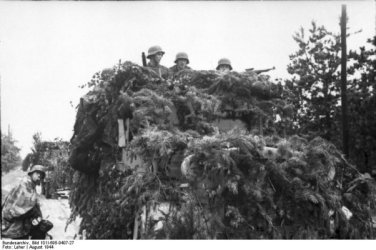
German photo showing German soldiers on camouflaged trucks on the forest road,
most probably taken during combat against insurgents in the outskirts of Warsaw (Bundesarchiv);
In order to destroy Polish forces in the Kampinos, Germans engaged about 6 000 soldiers divided into two groups supported by tanks and aircraft. Although the partisans were driven out of only two defensive positions, as a result of air bombardment of Wiersze and Brzozówka villages, the "Kampinos" Group Commander, Major Alfons Kotowski pseudonym "Okoń" decided to retreat and ordered a tiresome march of the Group towards the Góry Świętokrzyskie.
The route of the "Kampinos" Group composed of infantry soldiers, cavalrymen and about 350 wagons, was as follows: 27/28 of September 1944: start from Wiersze village towards a forest in the Bielin village area, 28 of September 1944: a whole day rest.
Further march undertaken in the evening of 28 of September 1944 led from the Bielin village area towards the sacred spot "Zamczysko" where the Group turned south.
Yet before midnight on 28 of September, 1944, the "Kampinos" Group soldiers in the Wiejca village area (east from Kampinos village) had to engage in combat with German forces in order to break through German lines. During the night march and at the time of crossing the Utrata river, the Group's rear guard was attacked by German armoured cars, most probably the SdKfz 251's.
The whole of the additional German forces consisted of 2 000 soldiers, an armoured train number 40 and about 40 armoured cars, mainly the SdKfz 251's (Sonderkraftfahrzeug 251). Allegedly, the operation was supported by few (five?) tanks, most probably the PzKpfw IV Ausf. H's.
Some of the units were partially destroyed in the fight by the Utrata river and afterwards represented a very little combat force. Those were the 1st Cavalry Squadron and the "Jerzyki" Company.
It was early morning on 29th of September 1944 when the vanguard of the "Kampinos" Group commanded by Cavalry Sergeant "Świerk" came across the German forces while entering the village Budy Zosine. Surprised enemy soldiers surrendered to the Polish cavalrymen without firing a single shot. Another scout unit commanded by Cavalry Sergeant "Łotysz" reached the railroad nearby the railroad crossing in Budy Zosine. Cavalrymen stopped in the alder wood nearby the train shed occupied by German soldiers and sent a report to Colonel "Okoń" informing that there are only few enemy soldiers ahead of them.
For certain reasons, decision to order a rest was rational. Soldiers could have a rest, have some food in the village and in the meantime, the rest of the Group units which were still marching, including the rear guard of the column, would have time to catch up with soldiers who stopped to rest. However, despite being tired, soldiers were still able to go an extra mile and cross a dangerous railroad, and then stop to rest behind the railroad. About 7 o'clock in the morning, majority of the Group reached the resting area in Budy Zosine, whereas the rear guard, the Group's supply wagons and stranded-from-their-units soldiers stayed in Baranów.
The attack caused panic in the back column, mainly in the supply wagons column. Polish soldiers fired back at Germans and as a result of it, German armoured cars temporarily retreated. Allegedly, another reason for their retreat was their fear to move too far into the village where among buildings, armoured cars could be easily destroyed with grenades or gasoline filled bottles. However after short time, the armoured cars received support in the shape of the 70th pgren 73 Infantry Division commanded by Colonel König which started coming in into the area from the north. About 9.45 in the morning, German armoured cars, supported by infantry, tried to detour the village in order to surround the "Kampinos" Group forces. As a consequence of this manoeuvre, Polish soldiers had no choice but to retreat.
Some sections managed to push the German pickets and cross the tracks. Those who crossed the tracks were soldiers of the 1st platoon commanded by Master Corporal Stanisław Paszkuć pseud. "Lampart" and a platoon commanded by Master Corporal Tumiłowicz, the both sections were parts of a company commanded by Sergeant "Opończa". When joy and optimism prevailed among the Poles, and it seemed, against all odds, they will be able to cross the tracks, a German armoured train approached from the Żyrardów direction. According to the Polish sources, it was not a proper armoured train but an ad hoc organised unit sent to Jaktorów. The armoured train approached from the Żyrardów direction and immediately opened heavy fire from its guns and machine guns. What's worse, the German train crew had an excellent in sight. Tracks on which the train was moving were situated on a railway embankment elevated over a marshy plain.
After the "Kampinos" Group cavalrymen bravely broke through and escaped the trap, other isolated units successfully retreated and the remaining Polish resistance points were neutralised by Germans, the battle of Jaktorów slowly ended in the evening of 29th of September, 1944. However, the 9th German Army daily report mentioned further fights which took place at 10.50 p.m. in the northern-east area from Żyrardów.
Apart from above, it needs to be taken into account that many partisans, as Adam Borkiewicz wrote: "ran for their lives and dispersed towards the nearby villages, abandoned their weapons and got changed in civilian clothes." Text: Szymon Nowak
Bibliography: Copyright © 2018 SPPW1944. All rights reserved.
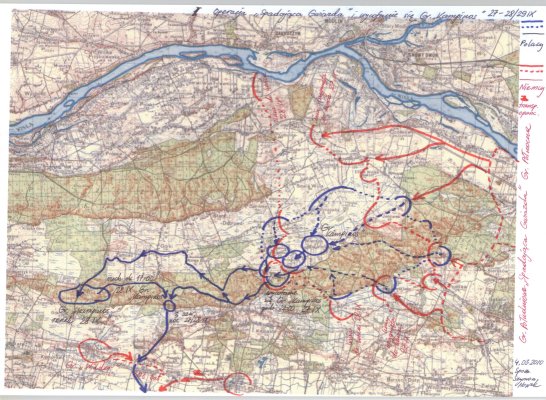
Operation "Falling Star", directions of the retreat route of the "Kampinos" Group
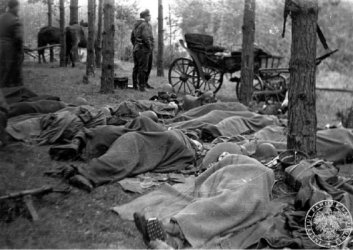
Soldiers of the "Kampinos Group" resting after a whole-night-march in the area of villages Zamość and Górki Polskie
(Collection of IPN (Institute of the National Remebrance), L. Gąszewski, 28 września 1944r., IPN BU 1132, neg.8, kl.199);
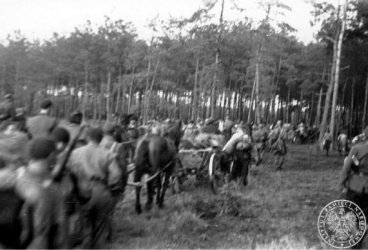
Units forming a marching formation and preparing to a night march
(Collection of IPN (Institute of the National Remebrance), L. Gąszewski, 28 września 1944r., IPN BU 1132, neg.8, kl.199);
Luckily, the main Polish forces managed to get away, however the route of the march became known to the Germans who regrouped their forces during the night and prepared to attack the "Kampnos" Group in the Żyrardów area. When early morning on 29 of September, 1944 the "Kampinos" Group was reaching the area of villages Stanisławów, Baranów and Budy Zosiny, Germans formed an additional unit which composed of the 70th pgren 73rd Infantry Division under command of Colonel König, one security battalion, two companies of armoured cars and a tank platoon.
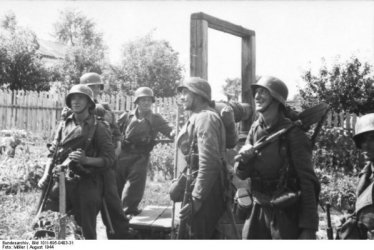
German photograph showing resting and laughing German soldiers by the well,
most probably taken during combat against insurgents in the outskirts of Warsaw (Bundesarchiv);
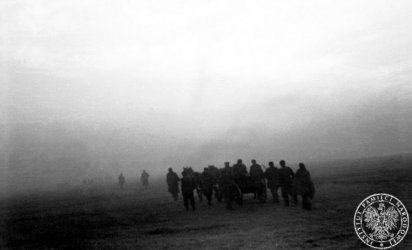
A column of the Polish Home Army "Kampinos" Group in the morning mist reaching Baranów before the Battle of Jaktorów
(Collection of IPN (Institute of the National Remebrance), author: E. Widlicki, 29.09.1944, IPN BU 1133, neg.5, kl.29A);
At that time, because of the night combat and the fact that certain number of soldiers dispersed and lost touch with the main column, the strength of the "Kampinos" Group weakened and just before the battle consisted of some 1 200 soldiers. The "Kampinos" Group was commanded by Major Alfons Kotowski pseudonym "Okoń". The core of the "Kampinos" Group composed of the "Palmiry-Młociny" Regiment commanded by Lieutenant Adolf Pilch pseud. "Dolina", a battalion commanded by Lieutenant Witold Lenczewski pseud. "Strzała", a company of cavalry commanded by Warrant Officer Zdzisław Nurkiewicz pseud. "Nieczaj", this cavalry company consisted of four cavalry squadrons and one heavy machine guns squadron, as well as units which were not parts of the original structure of the Regiment and those were: the Legionów Battalion commanded by Lieutenant Bolesław Szymkiewicz pseud. "Znicz", a company of Lieutenant Stefan Matuszczyk pseud. "Porawa", a company of Lieutenant Tadeusz Gaworski pseud. "Lawa", and the "Jerzyki" Company commanded by Lieutenant Jerzy Strzałkowski pseud. "Jerzy".
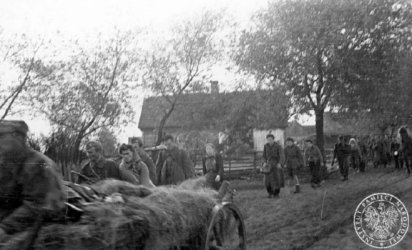
Aircraft Company of "Lawa" along with other units of the "Kampinos" Group leaving the Puszcza Kampinowska
(Collection of IPN (Institute of the National Remebrance), L. Widlicki, 28.09.1944, IPN BU 1133, neg.5, kl.28A);
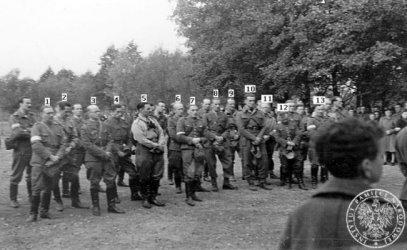
The officers of the "Kampinos" Group during field service, from the left: 1. Colonel Alfons Kotowski pseud. "Okoń", 2. Captain Zygmunt Koc pseud. "Dąbrowa", 3. Lieutenant Bogdan Jaworski pseud. "Wyrwa",
4. Second Lieutenant Lech Żabierek pseud. "Wulkan", 5. Lieutenant Adolf Pilch pseud. "Dolina", 6. Second Lieutenant Zygmunt Sokołowski pseud. Zetes", 7. Lieutenant Witold Lenczewski pseud. "Strzała",
8. Lieutenant NN pseud. "Gniew", 9. Lieutenant Stefan Iwanowski pseud. "Domek", 10. Lieutenant Tadeusz Gaworski pseud. "Lawa", 11. Lieutenant Henryk Kędzierzawski pseud. "Leszczyc",
12. Sergeant Walery Żuchowicz pseud. "Opończa", 13. Sergeant Stefan Andrzejewski pseud. "Wyżeł"
(Collections of of IPN (Institute of the National Remebrance), author: E. Widlicki, probably taken 10.09.1944, IPN BU 1133, neg.5, kl.2A);
The "Kampinos" Group commander decided not to charge and take the train shed and cross the railroad. Instead, Colonel "Okoń" ordered the vanguard to comeback and join the rest of the squadron. It could seem that the Group would go on marching, but the Commander "Okoń" decided otherwise. Facing the great tiredness of the Group after the overnight march within which the Group had several skirmishes with the Germans, as well as the fact that the Group was stretched on a quite big area, the length of the column was few kilometres long, the commander of the "Kampinos" Group ordered the Group to stop and rest. The front of the column stopped to rest in the distance of about 500 metres from the Warsaw-Skierniewice railroad.
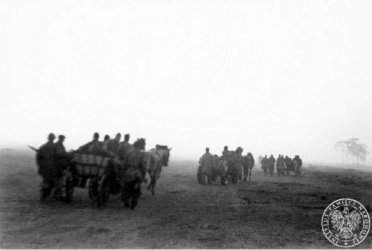
Streched column of the "Kampinos" Group supply wagons in morning mist
(Collections of of IPN (Institute of the National Remebrance), L. Gąszewski, 29.09.1944, IPN BU 1132, neg.8, kl.213);
When the fog subsided and the sun appeared, a German reconnaissance aircraft Focke-Wulf Fw 189 called colloquially "frame" showed over a village. It became certain that Germans know the location of the "Kampinos" Group and suspect its further route. Despite the tiredness, most of the Group's officers tried to persuade Major "Okoń" to alert the Group and move out immediately, but their efforts were of no avail. In the meantime in Baranów, about 8 o'clock in the morning, the rear guard of the "Kampinos" Group commanded by Lieutenant "Dolina" were attacked by German forces. The Polish units stationed in Baranów composed of the company of Wiersze commanded at the time by Second Lieutenant Józef Regulski pseud. "Biały" who replaced the earlier wounded commander Lieutenant Franciszek Wiszniowski pseud. "Jurek" and the 3rd Squadron commanded by Cavalry Sergeant Narcyz Kulikowski pseud. "Narcyz". German armoured cars appeared from the Kaski village direction and started firing towards the Group's supply wagons. Five wagons were destroyed straightaway, soldiers got killed and wounded.
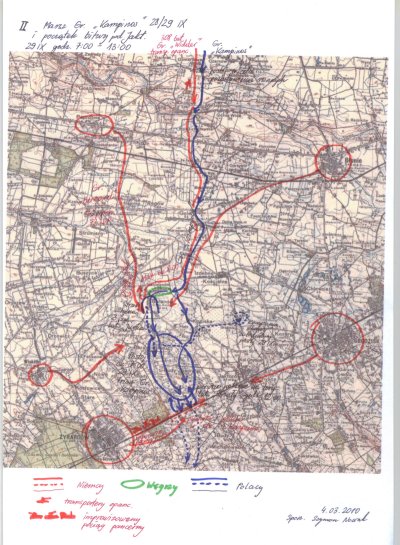
Route of the "Kampinos" Group, stay in the Budy Zosine area and the first phase of the battle 28/29.09.1944 until to 1 p.m.
Meanwhile, the main forces of the "Kampinos" Group were still inactive and resting in Budy Zosine, even though insurgents heard shots fired from the direction they came from, i.e. Baranów. In a way, it had a disheartening impact on soldiers as they stood still awaiting orders to move out and carry on their march. And no order at all was given. When a message came through informing that Germans started taking positions at the Warsaw-Skierniewice railroad, most probably this task was carried out by the Żyrardów German garrison, and the "Kampinos" Group commander still gave no orders whatsoever, some of the Group's officers started to express their disappointment with Major's Kotowski commanding impotency. It appeared that the "Kampinos" Group commander was slightly losing temper and an ability to command the Group. Perhaps, the decision to give soldiers time to rest while the rear guard could catch up with the main forces, from certain perspective, was the right order, however such an order given in the above described situation sealed the fate of the "Kampinos" Group.
Some units decided to leave the main group and try their luck on their own. That is what happened with a company commanded by Lieutenant Tadeusz Gaworski pseud. "Lawa". Some other soldiers also left their units as they did not believe they would be able to continue their march. Those were mainly soldiers from the outskirts of Warsaw, among others, the Legionów and the "Jerzyki" units. It needs to be underlined that soldiers were dispersing practically throughout the whole night march. Meanwhile, about 10 o'clock in the morning, Lieutenant Adolf Pilch pseud. "Dolina" and his rear guard soldiers along with part of the supply wagons, retreated from Baranów and joined the main Group stationed in Budy Zosine.
At the same time, a German reconnaissance aircraft Focke-Wulf FW 189 showed up again on the sky. Circled over the Polish positions several times and then descended and started firing at the Group soldiers and the supply wagons. The firing wreaked havoc and caused panic mainly among horses. The aircraft's action caused reaction and insurgents started firing back at the plane from all kinds of weapons they had. What interesting and quite unusual, Polish soldiers managed to shot down the "frame" which crashed nearby the railroad. It was one of the very few moments of happiness on this very difficult day for the Polish soldiers.
Most probably under the influence of a message saying that German armoured cars conquered Baranów located in the near distance from the location of the Group, about 11 o'clock in the morning Major "Okoń" made his mind and decided to cross the railroad and move the Group southbound. Major Kotowski called a meeting, summoned his officers and communicated his decision to divide the whole Group into two smaller groups. Tasks of the two columns were as follows:
- First group: a battalion commanded by Lieutenant Witold Lenczewski pseud. "Strzała" was tasked with taking position at the railroad crossing in Budy Zosine. This group meant to neutralise the German forces around the railroad and then take positions at the Żyrardów-Grodzisk road and uphold the both grounds until the rest of the first group arrives. The rest of the first group included the rest of infantry, the supply wagons, wagons carrying wounded and others.
- Second group: consisting of, let's call them "fast units", the whole cavalry and the Group commander and his staff, meant to cross the railroad in the distance of 1.5 kilometres on their right, through the crossing in Międzyborów.
- The gathering point for the both groups, after the groups have crossed the railroad and the Żyrardów-Grodzisk road, was designated in the Puszcza Mariańska.
Around noon, the Lieutenant "Strzała"'s battalion advanced towards their enemy. At the time, the first group soldiers were approaching the railroad, German soldiers fired their machine guns and rifles. After a moment, the Polish fired back their heavy machine guns, machine guns, pistols and rifles and this firepower overwhelmed the Germans and covered the charging units. Weak German forces were unable to hold the ground. At first, German soldiers retreated and took position at railway embankment, but as a result of another Polish advancement, they had to retreat further. Polish companies reached the tracks and took position right before the embankment.
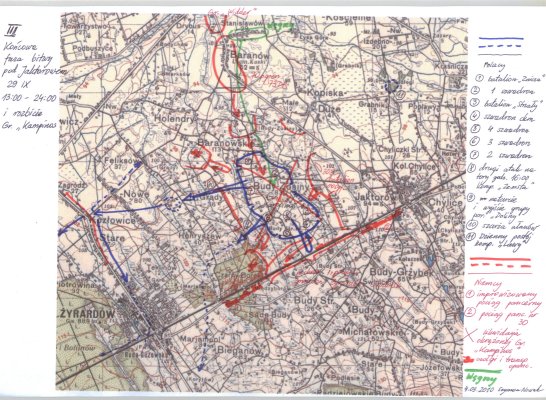
The second phase of the Battle on 29.09.1944, hours: 1 p.m.-12 a.m.
An open field on which the Polish forces were located when the armoured train arrived, was instantly covered with leaves and branches of very few trees mowed down by the bullets, German heavy fire caused sand and soil explosions, and set buildings in the village on fire. The supply wagons, moving right behind the 2nd battalion, were hit the most, especially the ammo wagons of the heavy machine guns company. The hit ammo wagons literally flew into the air, and as a result of the explosions, the wounded and scared horses raged around. The armoured train fire also cost the "Kampinos" Group more and more of the dead and wounded. At the same time, Polish soldiers released 100-150 German POW's who marched with the Group from the beginning of their march from the Kampinos.
The-first-wave soldiers of a battalion commanded by "Strzała" were obliterated and ripped apart by the embankment and survivors had to leave their positions and retreat. The main forces of the battalion along with his commander had to cease charging and retreat beyond the range of the armoured train fire. The ground left by the Poles was instantly taken back by German infantry. Weapons in possession of the Polish infantry were useless against the armoured train. Also the PIAT's, supplied from the air, could not do the job because of its range limitation as well as the dearth of ammo.
When the destroyed sections of the battalion commanded by "Strzała" retreated from under the embankment, they created a formation in the shape of a big quadrangle based on numerous drainage ditches located in the area. The ripped apart battalion commanded by "Strzała" along with a company of heavy machine guns of the 23rd Regiment commanded by Lieutenant "Jar" took positions at the ditch on the eastern side of Budy Zosine village as well as another ditch parallel to the tracks at its south end. On the left from the position of the heavy machine guns' company, there was located a cavalry squadron partially destroyed in the fight at the Utrata river. From the north was deployed the Legionów battalion commanded by Lieutenant Bolesław Szymkiewicz pseud. "Znicz" securing the Polish positions from the Baranów direction. The rest of the area was secured by cavalry units in the following order: the 4th squadron took positions on both sides of the road located parallelly to the railroad, they had the company of heavy machine guns on their left, the 3rd squadron's task was to secure the area from the Żyrardów direction and they took positions at the drainage ditches, the 2nd squadron was as if an extension of the defensive positions of the 3rd squadron and took positions between the 3rd squadron and the Legionów battalion commanded by "Znicz". Lieutenant "Dąbrowa" stayed with the 4th squadron.
The remaining units along with many supply wagons were situated in the center of this big quadrangle. From the south, the Group was stopped by German infantry positioned at the embankment and the armoured train. From the north, German units supported by armoured cars were already in Baranów. The Group was not surrounded as there was no enemy on their west and east flank. And decisive actions in those directions seemed to be the only way out, even if it meant leaving supply the wagons behind. Getting away from this trap required making fast decisions by the commander and quick manoeuvres of the Group. Time was not on the "Kampinos" Group side, however no orders were still given.
After neutralising the Polish Group's attempt to take the railroad, Germans started advancing from several directions supported by tanks. From the tracks and the Żyrardów direction appeared tanks accompanied by infantry. Polish positions were also attacked by armoured cars and German infantry advancing from Wiskitki village. Luckily for the Poles, the advances did not succeed and several German armoured cars were knocked out and destroyed, mainly by the PIAT bombs.
After the Group soldiers did not reach the tracks and were pushed back, at first, the Group commander decided to defend their positions until night. Soon after, the decision was changed as a result of the German fire that was directed on the building in which the commander and his staff resided. The new order of Major Kotowski given at 4 p.m. was the whole Group to break through towards the northern-west. The order caused chaos among the insurgents ranks, part of the units immediately started to regroup towards the ordered direction, whereas some units did not receive the order at all. The mystery is why right after the order was given to break through in the northern-west direction, Major "Okoń", mainly along with the company "Zemsta", made an attempt to break through the railroad in the opposite direction, the south.
The first wave of the Polish advance, among other units, mainly consisted of the 2nd and the 3rd platoon of the "Zemsta" company. Whereas the 1st platoon of Lieutenant "Porawa" stayed and acted as the rear guard. When Polish units were spreading and making ready to charge, two German armoured cars showed up. One of them, came from the Grodzisko direction and it was a proper armoured train #30, whereas the other one, it was the same train which was used against the Polish partisants on the same day in the morning. The armoured train carried tanks on its open box wagons and came from the Żyrardów direction. The firepower of the both trains was overwhelming and it disorganised the Polish units prepared to advance, as well as the supply wagons and the Polish cavalry situated at the back of the Polish positions. Moreover, one of the trains brought infantrymen who jumped out of the train. Instead of advancing, insurgents got stuck under the German fire.
The second wave of the Polish advance was destroyed at the bottom of the embankment and disorganised sections retreated under the cover of the drainage ditches towards the center of the Polish positions. About 5 p.m., Major "Okoń", who was located nearby the 2nd squadron positions, went towards the supply wagons to make sure that the ammunition is supplied on positions. And that was the place the commander was last seen alive. The next day the commander's body was found among the fallen soldiers. More or less, at the time Major "Okoń" decided to move towards the supply wagons, commanding duties were taken over by Lieutenant "Dolina" who sent dispatchers to those Polish positions to which the dispatchers were able to get to and ordered the Group soldiers to break through towards the southern-west direction. The order given by Lieutenant Adolf Pilch also instructed that any unit that is unable to move in the ordered direction should try and escape the trap in any possible direction.
The group units, as if on their own, tried to get away from the trap. A group of soldiers led by Lieutenant "Dolina" was moving on their feet towards the southern-west direction. After crossing two enemy lines, a unit of about 50 soldiers crossed the railroad and well after midnight arrived into forester's cabin in the Puszcza Mariańska.
The cavalry commander, Warrant Officer "Nieczaj", also prepared his units to charge in the west direction, towards Grądy village. According to given orders, the first wave of the charge should be about 200-300 cavalrymen strong and composed of the 2nd and the 4th squadron, as well as the 1st squadron, partially destroyed in the fight at Utrata river. Among the officers in this group were the following: Warrant Officer Zdzisław Nurkiewicz pseud. "Nieczaj", Cavalry Sergeant Józef Niedźwiecki pseud. "Wołodyjowski", Second Liuetenant Aleksander Pietrucki pseud. "Jawor" and the Kampinos drop zone commander, Major Bronisław Lewkowicz pseud. "Kurs". Cavalrymen of the 3rd squadron under command of Cavalry Sergeant "Narcyz" meant to stay at their positions and cover the charging units. After 2 hours from the moment the charge begun, cavalrymen of the 3rd squadron meant to charge in the same direction as the second wave. About 6 p.m., on Warrant Officer "Nieczaj"'s command, the 3rd squadron cavalrymen started advancing.
Corporal Franciszek Kosowicz pseud. "Maciejka" who was with the 1st squadron at the time, wrote in his memoirs published in Adolf Pilch's book "The Partisans of three forests": "So far we rode a medium gallop. Every cavalrymen now pricked his horse with spurs to reach the maximum speed. The enemy shot at us with all their weapons. The roar of the exploding bullets mixed up with screams of the wounded. People and horses fell. The others galloped as fast as they could. Buildings appeared in front of us, some trees. A shell hit a building and it exploded. We reached a small river. Most of the horsemen jumped over it galloping. Others fell not reaching the riverbank. We galloped on, just to get out of the range of the German fire. Groups of cavalrymen from other squadrons joined us from from the left. The sun was already set, but the sky was still turning red in the west.
The enemy is located in front of us in the village and shots at us fiercely. Probably the enemy soldiers were surprised by our soldiers as its fire becomes chaotic. We shot back running. Galloping next to the enemy positions we threw grenades at them and did not care whether or not we could be hit by the grenade shards. Finally we reached a poorly wooded area, but at least it was some sort of a cover. The enemy fire could not directly reach us now. The battle still raged on around us. We had to gradually reduce the speed as the horses were completely exhausted. We saw two tanks on the hill about a kilometre away from us. We suspected that the tanks will throw at us all the hell they had. The tanks stood on the road we were going to cross and we slowly moved towards the west. We reached the bushy side of the road. The falling darkness hindered the visibility. We jump through the road and changed direction towards the north. We reached the Grąd area. We had to stop for a moment. It was already dark".
About 140-200 cavalrymen managed to break through the enemy lines. While resting in Grądy, the 1st, 2nd and 4th squadron estimated their losses. After the cavalry charge among the missing soldiers were Cavalry Master Sergeant Józef Niedźwiecki psued. "Lawina" and Warrant Officer Zdzisław Nurkiewicz pseud. "Nieczaj" who was wounded during the charge and left behind. The new commanding officer, because of his highest rank, was Major Bronisław Lewkowicz pseud. "Kurs" who ordered a rest. During the rest, the cavalrymen were joined by other cavalry soldiers who lost their horses during the charge and smaller groups of infantry soldiers. Among officers and commanding staff in Grądy were: Major "Kurs", Second Lieutenant "Jawor", Master Cavalry Sergeant "Wołodyjowski", Cavalry Sergeant Konstanty Downar, Cavalry Master Sergeant Antoni Zolotar pseud. "Szczerbiec". After about two-hour rest, Major "Kurs" ordered the Group to march out towards the Puszcza Miariańska, detouring nearby Żyrardów from the north and the west.
The group moved carefully between villages and while trying to cross the Wiskitki-Oryszew road, the group was shot at from close range by German machine guns. The front of the group spontaneously charged the German positions. At this time, Cavalry Master Sergeant "Wołodyjowski" (J. Jakubowski) got wounded and part of the unit, mainly those who were at the back, dispersed in the dark. One section of the 4th squadron commanded by Second Lieutenant "Jawor" turned left southbound and detoured the German positions. Galloping cavalrymen of the 4th squadron suddenly appeared on the streets of Żyrardów. The town seemed deserted at the time of their appearance about 8.30-9 p.m. and there were only few residents in the streets. The German garrison of Żyrardów marched out earlier and engaged in fighting partisans in Jaktorów.
Cavalrymen galloped through the streets and the market square without being shot at. Those who managed to get through Żyrardów turned towards the Puszcza Kampinowska. The front group with Major "Kurs", after they managed to breakthrough the German positions, was about 60 cavalrymen strong. It was decided to carry on towards the Puszcza Mariańska. After crossing the railroad, the group reached the Puszcza Mariańska area and met with Lieutenant "Dolina" and his unit.
A questionable order of Major "Okoń" ordering an immediate retreat completely disorganised Polish defense in the Budy Zosiny area. An assumption can be made that the battle of Jaktorów was lost at that moment when such an order was given and as a result, the "Kampinos" Group was destroyed and dispersed. Some units in accordance with the order, retreated towards the northern-west, others tried to escape the trap on their own. The charge of the partisan cavalry which took place about 6 p.m. and which was the result of the retreat order, broke the Polish defensive formation and caused its penetration by German infantry supported by armoured cars.
Apart from German soldiers, the battlefield was entered from the north by Hungarian units which stationed in Stanisławów. However their attitude towards Polish soldiers was completely opposite. Yet during the battle and after it ended, the heroic Hungarian troops pretended to take Polish soldiers prisoner and then let them go free. In Budy Zosine, Hungarian soldiers took Polish POWs' side and saved them when the SS soldiers tried to take over the prisoners and most probably execute them, the Hungarian soldiers then threatened the SS soldiers to turn their weapons against them if they tried to harm the Polish POW's.
Despite the fact that German infantry managed to penetrate the Polish defense lines at its center and gradually took the Budy Zosine area, other Polish units still fought on and held their positions. As time went by and most of the Polish positions were taken by the enemy troops, Polish defensive lines narrowed and became isolated. Very few isolated resistance points fought on, and when the night came, tried to break through.
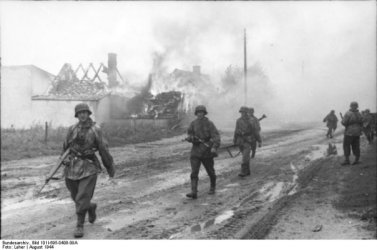
German photo showing German soldiers most probably in action against Polish insurgents in the Warsaw area (Bundesarchiv);
On 30th of September, starting early morning at 6.30, German forces cleared the ambush and fully controlled the area nearby Żyrardów. As a result of the skirmish near Seroki-Parcela village 8 partisans were killed and 11 taken prisoner. There were no partisans left in the battlefield, the Budy Zosine area. Small groups of insurgents of the destroyed "Kampinos" Group, which were surrounded in the evening of the 29th, broke through the enemy lines under cover of the night and dispersed in the area or hid and waited till another night. A very large part of the destroyed "Kampinos" Group which managed to break through on their own, found shelter and hospitality of both, the local residents and the local Polish Home Army units. It happened in Żyrardów and nearby villages and towns. Some units marched on properly organised.
The largest group of partisans was gathered around Lieutenant "Dolina" and this group was about 200 soldiers strong and composed of cavalry brought by Major "Kurs" and other smaller groups. Those groups at first gathered in nearby woods. After few days of resting Lieutenant "Dolina" led the Independent Squadron of the "Kampinos" Group towards the Lasy Opoczyńskie where in October 1944 this unit consisting of only 80 partisans at the time joined the 25th Piotrków-Opoczno Infantry Regiment of the Polish Home Army sub-area Piotrków. Other group joined a Polish Home Army unit commanded by Antoni Heda pseud. "Szary". And some partisans turned and moved back to the Kampinos Forest where they found shelter.
The battle of Jaktorów was one of the biggest partisan battles during WWII which took place on the left bank of the Vistula river. It also was one of the significant one-day fights during the Warsaw Uprising. As a result of the battle, the "Kampinos" Group was destroyed and ceased to exist. During its two-month existence the "Kampinos" Group fought about 46 battles and skirmishes with German troops, inflicting severe losses among the enemy. (...) Polish losses according to Adam Borkiewicz amounted to 150-200 killed in action, 120 wounded and 150 taken prisoner.
The above statistics, to some extent, are mirrored by the number of graves at the cemetery in Budy Zosine, where 132 fallen insurgents are buried, as well as by a document prepared by Jerzy Koszada and titled a List of Warsaw Insurgents 1944 fighting within "Kampinos" Group, where among the fallen on the 29th and the 30th of September, 1944 in the Budy Zosine, Jaktorów and Żyrardów (those soldiers probably died from wounds) areas, the List mentions a number of 183 Polish soldiers.
The German casualties were about 100-150 killed and wounded, apart from human losses, the Germans lost several destroyed and damaged armoured cars and the shot down aircraft Focke-Wulf Fw 189. The Polish losses included almost the whole heavy military equipment, ammunition, supply wagons and other military equipment. Among Polish commanders taken prisoner were: Second Lieutenant Józef Regulski pseud. "Biały", Master Sergeant Józef Niedźwiecki pseud. "Lawina", Master Sergeant Jan Jakubowski pseud. "Wołodyjowski" and Lieutenant Jerzy Strzałkowski pseud. "Jerzy". Among wounded were: Lieutenant Witold Lenczewski psued. "Strzała" and Warrant Officer Zdzisław Nurkiewicz pseud. "Nieczaj". Among the high rank commanders killed during the battle were: Lieutenant Franciszek Wiszniowski pseud. "Jurek", Lieutenant Władysław Ludwig pseud. "Kamil" (vice commander of the Zemsta" Company which originated from the "Wigry" scouts battalion), Lieutenant Jan Raczkowski pseud. "Motor" (company commander of the "Znicz" Battalion), Cavalry Sergeant Narcyz Kulikowski pseud. "Narcyz" (3rd Squadron commander) and the "Kampinos" Group commander, Major Alfons Kotowski pseud. "Okoń".
Author of a book "Puszcza Kampinoska-Jaktorów"
published by Bellona Publishing House
Edit: Maciej Janaszek-Seydlitz
Translation: Janusz Kocerba
1. Bielański Ryszard "Góra - Dolina" Adolf Pilch, Warszawa 2007;
2. Bielecki Robert i Kulesza Juliusz Przeciw konfidentom i czołgom. Oddział 993/W Kontrwywiadu Komendy Głównej AK i Batalion Pięść w konspiracji i Powstaniu Warszawskim 1944 roku, Warszawa 1996;
3. Borkiewicz Adam Powstanie Warszawskie. 1944. Zarys działań natury wojskowej, Warszawa 1964
4. Koszada Józef "Harcerz" Grupa Kampinos. Partyzanckie zgrupowanie Armii Krajowej walczące w Powstaniu Warszawskim, Warszawa 2007;
5. Krzyczkowski Józef "Szymon" Konspiracja i Powstanie w Kampinosie 1944, Warszawa 1961;
6. Kuźmiński Józef Jan Z Iwieńca i Stołpców do Białegostoku, fragmenty, www.iwieniec.eu/AK/;
7. Lenczewski Witold por. "Witold", "Strzała" i Hoppen - Zawadzka Jadwiga Pięć lat na wojennych ścieżkach, Łódź 1998;
8. Na przedpolu Warszawy, Zeszyty Historyczne Okręgu Warszawa-Powiat Światowego Związku Żołnierzy Armii Krajowej, Nr 2/3, 4, 7, 8,Warszawa 1994 - 1995;
9. Pilch Adolf Partyzanci trzech puszcz, Warszawa 1992;
10. Podgóreczny Marian "Żbik" Doliniacy. Nieznane dzieje Zgrupowania Stołpecko-Nalibockiego AK, tom 1-3, Gdańsk 1991/1993;
11. Podgóreczny Marian "Żbik" Doliniacy., tom 1-3, Wyd.2, Warszawa 2010;
12. Sawicki Tadeusz Rozkaz: zdławić powstanie. Siły zbrojne III Rzeszy w walce z Powstaniem Warszawskim 1944, Warszawa 2001;
13. Wielka Ilustrowana Encyklopedia Powstania Warszawskiego, tom 1, Warszawa 2005;
14. www.powstanie-warszawskie-1944.pl, strona internetowa Tomasza Zatwarnickiego "Whatfora".
Notice: the whole text can be found in the "Militaria XX w." magazine No 01(52)/2013
